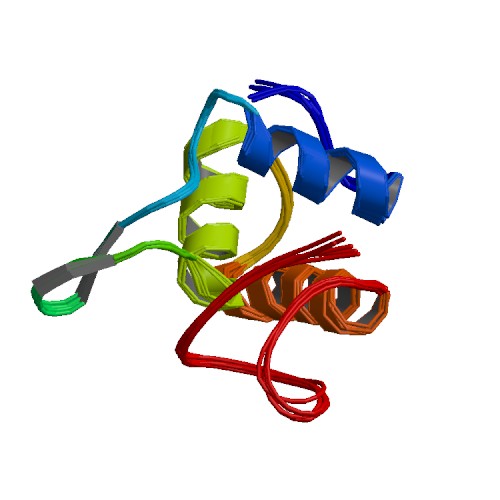DVL1
| Dishevelled, dsh homolog 1 (Drosophila) | |||||||||||||
|---|---|---|---|---|---|---|---|---|---|---|---|---|---|
 PDB rendering based on 1fsh. | |||||||||||||
| |||||||||||||
| Identifiers | |||||||||||||
| Symbols | DVL1 ; DVL; MGC54245 | ||||||||||||
| External IDs | Template:OMIM5 Template:MGI HomoloGene: 20926 | ||||||||||||
| |||||||||||||
| Orthologs | |||||||||||||
| Template:GNF Ortholog box | |||||||||||||
| Species | Human | Mouse | |||||||||||
| Entrez | n/a | n/a | |||||||||||
| Ensembl | n/a | n/a | |||||||||||
| UniProt | n/a | n/a | |||||||||||
| RefSeq (mRNA) | n/a | n/a | |||||||||||
| RefSeq (protein) | n/a | n/a | |||||||||||
| Location (UCSC) | n/a | n/a | |||||||||||
| PubMed search | n/a | n/a | |||||||||||
Dishevelled, dsh homolog 1 (Drosophila), also known as DVL1, is a human gene.[1]
DVL1, the human homolog of the Drosophila dishevelled gene (dsh) encodes a cytoplasmic phosphoprotein that regulates cell proliferation, acting as a transducer molecule for developmental processes, including segmentation and neuroblast specification. DVL1 is a candidate gene for neuroblastomatous transformation. The Schwartz-Jampel syndrome and Charcot-Marie-Tooth disease type 2A have been mapped to the same region as DVL1. The phenotypes of these diseases may be consistent with defects which might be expected from aberrant expression of a DVL gene during development. Three transcript variants encoding three different isoforms have been found for this gene.[1]
References
Further reading
- Wharton KA (2003). "Runnin' with the Dvl: proteins that associate with Dsh/Dvl and their significance to Wnt signal transduction". Dev. Biol. 253 (1): 1–17. PMID 12490194.
- Klingensmith J, Nusse R, Perrimon N (1994). "The Drosophila segment polarity gene dishevelled encodes a novel protein required for response to the wingless signal". Genes Dev. 8 (1): 118–30. PMID 8288125.
- Pizzuti A, Novelli G, Mari A; et al. (1996). "Human homologue sequences to the Drosophila dishevelled segment-polarity gene are deleted in the DiGeorge syndrome". Am. J. Hum. Genet. 58 (4): 722–9. PMID 8644734.
- Pizzuti A, Amati F, Calabrese G; et al. (1997). "cDNA characterization and chromosomal mapping of two human homologues of the Drosophila dishevelled polarity gene". Hum. Mol. Genet. 5 (7): 953–8. PMID 8817329.
- Steitz SA, Tsang M, Sussman DJ (1997). "Wnt-mediated relocalization of dishevelled proteins". In Vitro Cell. Dev. Biol. Anim. 32 (7): 441–5. PMID 8856345.
- Semënov MV, Snyder M (1997). "Human dishevelled genes constitute a DHR-containing multigene family". Genomics. 42 (2): 302–10. doi:10.1006/geno.1997.4713. PMID 9192851.
- Bui TD, Beier DR, Jonssen M; et al. (1997). "cDNA cloning of a human dishevelled DVL-3 gene, mapping to 3q27, and expression in human breast and colon carcinomas". Biochem. Biophys. Res. Commun. 239 (2): 510–6. doi:10.1006/bbrc.1997.7500. PMID 9344861.
- Ikeda S, Kishida S, Yamamoto H; et al. (1998). "Axin, a negative regulator of the Wnt signaling pathway, forms a complex with GSK-3beta and beta-catenin and promotes GSK-3beta-dependent phosphorylation of beta-catenin". EMBO J. 17 (5): 1371–84. doi:10.1093/emboj/17.5.1371. PMID 9482734.
- Kishida S, Yamamoto H, Hino S; et al. (1999). "DIX domains of Dvl and axin are necessary for protein interactions and their ability to regulate beta-catenin stability". Mol. Cell. Biol. 19 (6): 4414–22. PMID 10330181.
- Fagotto F, Jho E, Zeng L; et al. (1999). "Domains of axin involved in protein-protein interactions, Wnt pathway inhibition, and intracellular localization". J. Cell Biol. 145 (4): 741–56. PMID 10330403.
- Li L, Yuan H, Weaver CD; et al. (1999). "Axin and Frat1 interact with dvl and GSK, bridging Dvl to GSK in Wnt-mediated regulation of LEF-1". EMBO J. 18 (15): 4233–40. doi:10.1093/emboj/18.15.4233. PMID 10428961.
- Inobe M, Katsube K, Miyagoe Y; et al. (2000). "Identification of EPS8 as a Dvl1-associated molecule". Biochem. Biophys. Res. Commun. 266 (1): 216–21. doi:10.1006/bbrc.1999.1782. PMID 10581192.
- Strovel ET, Wu D, Sussman DJ (2000). "Protein phosphatase 2Calpha dephosphorylates axin and activates LEF-1-dependent transcription". J. Biol. Chem. 275 (4): 2399–403. PMID 10644691.
- Song DH, Sussman DJ, Seldin DC (2000). "Endogenous protein kinase CK2 participates in Wnt signaling in mammary epithelial cells". J. Biol. Chem. 275 (31): 23790–7. doi:10.1074/jbc.M909107199. PMID 10806215.
- Hino S, Kishida S, Michiue T; et al. (2001). "Inhibition of the Wnt signaling pathway by Idax, a novel Dvl-binding protein". Mol. Cell. Biol. 21 (1): 330–42. doi:10.1128/MCB.21.1.330-342.2001. PMID 11113207.
- Rubinfeld B, Tice DA, Polakis P (2001). "Axin-dependent phosphorylation of the adenomatous polyposis coli protein mediated by casein kinase 1epsilon". J. Biol. Chem. 276 (42): 39037–45. doi:10.1074/jbc.M105148200. PMID 11487578.
- Chen W, Hu LA, Semenov MV; et al. (2002). "beta-Arrestin1 modulates lymphoid enhancer factor transcriptional activity through interaction with phosphorylated dishevelled proteins". Proc. Natl. Acad. Sci. U.S.A. 98 (26): 14889–94. doi:10.1073/pnas.211572798. PMID 11742073.
- Habas R, Kato Y, He X (2002). "Wnt/Frizzled activation of Rho regulates vertebrate gastrulation and requires a novel Formin homology protein Daam1". Cell. 107 (7): 843–54. PMID 11779461.
- Russ C, Lovestone S, Powell JF (2002). "Identification of genomic organisation, sequence variants and analysis of the role of the human dishevelled 1 gene in late onset Alzheimer's disease". Mol. Psychiatry. 7 (1): 104–9. doi:10.1038/sj/mp/4000941. PMID 11803455.
- Gao ZH, Seeling JM, Hill V; et al. (2002). "Casein kinase I phosphorylates and destabilizes the beta-catenin degradation complex". Proc. Natl. Acad. Sci. U.S.A. 99 (3): 1182–7. doi:10.1073/pnas.032468199. PMID 11818547.
| This protein-related article is a stub. You can help Wikipedia by expanding it. |